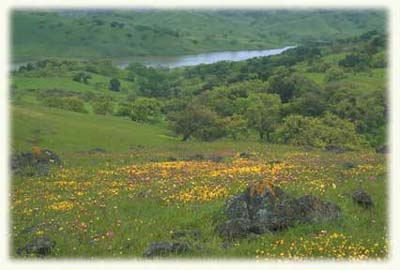|
 News News
 Subscribe to Our Newsletter Subscribe to Our Newsletter
 Sign up for Email Updates
Sign up for Email Updates
 CGF In the News
CGF In the News
 Press Inquiries Press Inquiries
 Past Articles Past Articles
 Calendar Calendar
|
|
|
Protecting Coyote Ridge
by Don Mayall
Driving south on 101 toward Morgan Hill,
one sees a long ridge to the east -- green now, but otherwise unremarkable when seen from the valley floor. On the ridgetop, however, one finds a place of sweeping vistas, home to singing grass, wildflowers,
eagles, falcons, and coyotes... but few people.

Known as Coyote Ridge, it consists of a rock known as serpentinite, or serpentine -- so-called because its unweathered pieces can be green and scaly like a snake. Serpentine's unique
mineral characteristic helped shape Coyote Ridge's amazing and unusual ecosystem that includes ten protected wildlife species and twelve rare plants.
Coyote Ridge's most famous resident listed as threatened by the U.S. Fish & Wildlife Service, the Bay Checkerspot butterfly, depends upon several plants that grow in the ridge's serpentine
soils. Suitable Bay Checkerspot habitat has been lost to development elsewhere in the valley. The last sizable population of this butterfly is found on Coyote Ridge, and this ridge is critical
to the butterfly's survival.
Unfortunately, development is not the only threat to butterfly habitat-habitat loss also occurs when non-native grasses invade
the area. This invasion has occurred in the valley as a result of air pollution and poor grazing practices. Well-managed grazing actually is now an essential conservation strategy needed to
control the invasive plants that threaten this native habitat.
Civilization is very close to this treasure, and expanding every day. Lines of new homes, factories, and golf courses are all advancing
on the serpentine ridges. For a number of reasons, Coyote Ridge is the most important area in need of preservation as open space in the Santa Clara Valley. This is why we must preserve it:
Coyote Ridge is a cornerstone in the belt of open space around Santa Clara Valley. Its preservation will protect the Santa Clara Valley from urbanization that would spread across
the Hamilton Range and join with the San Joaquin Valley.
Coyote Ridge is part of an intact ecosystem and wildlife corridor. The ridge is contiguous with public and undeveloped
lands to the north, east and south.
Coyote Ridge is a repository of rare and endangered species. The U.S. Fish & Wildlife Service has identified the
preservation of Coyote Ridge as key to the recovery of endangered species.
Coyote Ridge is a natural science laboratory. Scientists from Stanford University, U.C. Davis, Berkeley and elsewhere are
studying effects of soils, temperature, pollinators, and human environmental factors on the ecosystem here.
Coyote Ridge is part of our heritage. Unlike most of the rest of
the valley, it was not used for agriculture or development, and remains much as it was before the development of the valley.
The Committee for Green Foothills has joined with the Santa
Clara Valley Chapter of the California Native Plant Society (CNPS), the Loma Prieta Chapter of the Sierra Club, the Santa
Clara Valley Audubon Society, Greenbelt Alliance,
Acterra, and others in a coalition to ensure the protection and preservation of this remarkable area.
For more information about Coyote Ridge or to get involved with
the campaign to protect it, visit the CNPS Coyote Ridge website.
Don Mayall, a retired researcher from Ohlone College, has been a member of the Santa Clara Valley Chapter of CNPS since the mid-80s, and has served as Conservation South
Chair, Field Trip Coordinator, Vice President, and President. He currently serves as the Chapter's Rare Plant Coordinator for Santa Clara County.
Published May 2002 in Green Footnotes.
Page last updated July 24, 2003 . |
|
![]()
![]()




